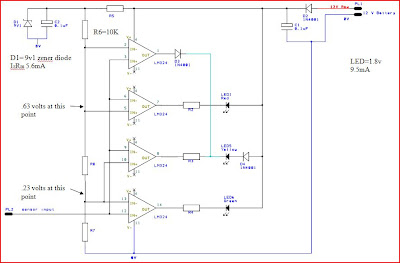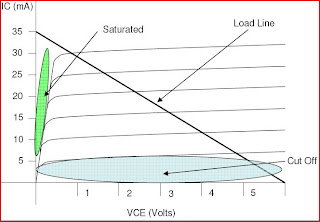 Parts Used
Parts UsedLED 35000 MCD Emitted Colour: Red Vf (V) Max: 2.6 If mA: 75 Vf (V) Type: 2.2
LED 35000MCD Emitted Colour: Yellow Vf (VMax:2.6 If mA: 75 (Vf) Type:2.2
LED 35000MCD Emitted Colour: Green Vf (V) Max: 2.6 If mA: 75 (Vf) Type 2.2
 Electrolyte Capcitors x2
Electrolyte Capcitors x2 9V1 Zener Diode
LM324AN 14pin Intergrated Circuit
R1 390R +/- 5% 0.5 Watts
R2 470R +/- 5% 0.5 Watts
R4 270R +/- 5% 0.5 Watts
R5/R6/R7 1K +/- 5% 0.5 Watts
D1/D2 1N4001 50V Silicone Diode 1 Amp
Jumper Wires
Additional 1V power supply
How it Works
Connected with a 12V supply, current flows through the first diode. The voltage is then lowered to 11.3V due to the operating voltage of the diode. Current then flows through the capacitor and towards the first LED, dropping the voltage by a further 1.8V, (9.5V)which then goes towards a 1K Resistor, and then to the 7th pin of the IC. With the Yellow LED, current flows through another 1N4001 Diode, which drops the voltage by 0.7V (10.6V), and then through the LED itself dropping the voltage by 1.8V (8.8V), through another 1K resistor and then to the 8th pin of the IC. For the last LED, there are no additional diodes, so voltage drop only occours across the LED itself (9.5V), which goes through a 1K resistor and then to the 14th pin. When the board is connected to a 12v supply on the positive and negative rails, only the Red LED should turn on. There is a lead on the 12th pin, (called the sensor input) we may now alter which LED's will come on, depending on the varying 1V voltage. As voltage is increased to 0.3V, the red LED will turn off and the yellow LED will turn on. When voltage is increased to 0.7 V, the yellow LED then turns off, and then the green LED will turn on.
Fault Finding
My first board I constructed had faults due to bad soldering. My LED's would blow and components would not operate, so I completely redesigned my board to make it much more user friendly and less complex. When my second board was constructed, My LED's would not turn on when additional voltage was added. After hours and hours of trying to solve the problem, I realised my IC was wired up wrong, and had to change my design once more. With only 1 day left to complete this circuit, I constructed one more, only to find out that my new board shorted out when I connected it to a power supply. With no other alternatives I had to scrap my board and start my write-up.













 LED
LED ZENER DIODE
ZENER DIODE Q2. Fill in the blanks
Q2. Fill in the blanks















 This chart has all the specifications of the 1N4007 diode that i will use in the following circuit.
This chart has all the specifications of the 1N4007 diode that i will use in the following circuit.



 In my recordings I noticed that the voltage drop across the diodes did not change when i varried the Voltage from 10V to 15V. This is because the zener diode constantly regulates the voltage to 5V1, and the 1N4007 diode only requires 0.7V to operate. The resistor on the other hand almost doubled the amount of voltage drop on itself when I increased the Vs to 15v. This is because the sum of V3 will always equate to 5.8V.
In my recordings I noticed that the voltage drop across the diodes did not change when i varried the Voltage from 10V to 15V. This is because the zener diode constantly regulates the voltage to 5V1, and the 1N4007 diode only requires 0.7V to operate. The resistor on the other hand almost doubled the amount of voltage drop on itself when I increased the Vs to 15v. This is because the sum of V3 will always equate to 5.8V.
 Diodes are components to prevent current from flowing both ways
Diodes are components to prevent current from flowing both ways The knee voltage is the amount of voltage needed for the diode to let electrons through.
The knee voltage is the amount of voltage needed for the diode to let electrons through. Zener Diodes
Zener Diodes 
